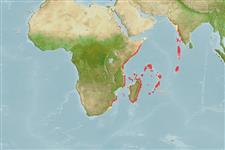Classification / Names
ชื่อสามัญ | ชื่อพ้อง | Catalog of Fishes(สกุล, ชนิด) | ITIS | CoL | WoRMS | Cloffa
>
Pleuronectiformes (Flatfishes) >
Soleidae (Soles)
Etymology: Aseraggodes: Greek, aggos, -eos, -ous = vessel, uterus, carapace of a crab + Greek, aseros, -a, -on = to remove the appetite (Ref. 45335).
Environment: milieu / climate zone / depth range / distribution range
นิเวศวิทยา
เกี่ยวกับทะเล,น้ำเค็ม สัตว์น้ำหน้าดิน; ระดับความลึก 0 - 35 m (Ref. 57561). Tropical
การแพร่กระจาย
ประเทศต่างๆ | พื้นที่จำแนกตาม FAO | ระบบนิเวศหลายระบบ | การปรากฏขึ้น,การเกิดขึ้น,พบ | Point map | การแนะนำ | Faunafri
Western Indian Ocean: Kenya to Chagos Archipelago, south to KwaZulu-Natal.
ขนาด / น้ำหนัก / Age
Maturity: Lm ? range ? - ? cm
Max length : 10.4 cm SL เพศผู้/กระเทย; (Ref. 33390)
Short description
สัณฐานวิทยา | ความยาวต่างๆ
ก้านครีบอ่อนที่หาง (รวม): 68-76; ก้านครีบอ่อนที่ก้น: 47 - 52; สัตว์มีกระดูกสันหลัง: 35 - 38. Diagnosis: Dorsal rays 68-76; anal rays 47-52; dorsal, anal, and pelvic rays are branched; lateral line scales 75-87, including about 11 anterior to a vertical at upper end of gill opening; lateral line on ocular side projecting toward dorsal edge of upper eye; vertebrae 35-38; dorsal pterygiophores anterior to fourth neural spine 13-15; body depth 2.3-2.6 in SL; head length (HL) 4.2-4.6 in SL; snout length 2.6-2.75 in HL; eye diameter 4.5-5.8 in HL; interorbital space narrow, the least vertical width 9.0-12.5 in HL; maxilla ending anterior to a vertical through middle of lower eye; upper end of gill opening on a horizontal passing about a half orbit diameter below lower eye; tubular anterior nostril reaching cutaneous edge of lower orbit when laid back; cirri well developed on front of snout, ventral side of head, operculum along both sides of gill opening, and along edge of membranous ridges of most dorsal and anal rays; caudal peduncle present, length 7.0-10.5 in HL; caudal-peduncle depth 1.65-1.9 in HL; longest dorsal ray 1.4-1.65 in HL; caudal-fin length 3.1-3.8 in SL; pelvic-fin length 1.55-1.75 in HL, reaching base of third or fourth anal ray; color of ocular side in alcohol light brown with many small dark brown spots or short lines and three rows of larger dark brown spots (though usually no larger than eye), one row below dorsal fin, one above anal fin, and one along lateral line; rays of fins light yellowish brown with a single series of brown spots, those on some rays darker than others. Head and body when fresh with numerous small white spots (but larger than small dark brown spots); with a series of white spots, one dorsally and one ventrally on body, of equal size to dark brown spots, one between each pair of dark spots (Ref. 57561).
Collected from clear water in a coral-reef environment; the deepest from sand beneath a ledge in 35 m depth (Ref. 57561).
Life cycle and mating behavior
วัยเจริญพันธุ์ | การสืบพันธุ์ | การวางไข่ | เซลสืบพันธ์ของเพศเมีย(ไข่) | ความดกของไข่ | ตัวอ่อน
Fricke, R., 1999. Fishes of the Mascarene Islands (Réunion, Mauritius, Rodriguez): an annotated checklist, with descriptions of new species. Koeltz Scientific Books, Koenigstein, Theses Zoologicae, Vol. 31:759 p. (Ref. 33390)
IUCN Red List Status (Ref. 130435)
Threat to humans
Harmless
Human uses
ข้อมูลเพิ่มเติม
ประเทศต่างๆพื้นที่จำแนกตาม FAOระบบนิเวศหลายระบบการปรากฏขึ้น,การเกิดขึ้น,พบการแนะนำStocksนิเวศวิทยาอาหาร, โภชนาการรายการอาหารการบริโภคอาหารอาหารสำหรับสัตว์น้ำแต่ละตัว
ชื่อสามัญชื่อพ้องกลไกการเผาผลาญพลังงานผู้ล่าการศึกษาเกี่ยวกับผลกระทบของสารประกอบทางเคมีที่เป็นอันตรายต่อสิ่งมีชีวิต ประชากร และสิ่งแวดล้อมการสืบพันธุ์วัยเจริญพันธุ์การวางไข่การรวมกลุ่มวางไข่ความดกของไข่เซลสืบพันธ์ของเพศเมีย(ไข่)Egg development
Age/SizeการเจริญเติบโตLength-weightLength-lengthLength-frequenciesความยาวต่างๆสัณฐานวิทยาตัวอ่อนพลวัตของสัตว์น้ำวัยอ่อนการทดแทนที่อุดมสมบรูณ์BRUVS
อ้างอิงการเพาะเลี้ยงสัตว์น้ำประวัติการเพาะเลี้ยงสัตว์น้ำสายพันธุ์พันธุศาสตร์ElectrophoresesอัตราพันธุกรรมโรคการแปรรูปNutrientsMass conversion
ผู้ร่วมมือรูปภาพหลายรูปStamps, Coins Misc.เสียงปลามีพิษ เช่น ปลาปักเป้าความเร็วรูปแบบการว่ายน้ำพื้นที่เหงือกOtolithsสมองวิสัยทัศน์
เครื่องมือ
Special reports
Download XML
แหล่งที่มาจากอินเตอร์เน็ต
Estimates based on models
Preferred temperature (Ref.
123201): 25 - 28.9, mean 27.3 °C (based on 366 cells).
Phylogenetic diversity index (Ref.
82804): PD
50 = 0.5000 [Uniqueness, from 0.5 = low to 2.0 = high].
Bayesian length-weight: a=0.00977 (0.00473 - 0.02021), b=3.07 (2.90 - 3.24), in cm total length, based on LWR estimates for this (Sub)family-body shape (Ref.
93245).
ระดับชั้นอาหาร (Ref.
69278): 3.6 ±0.5 se; based on size and trophs of closest relatives
ความสามารถในการกลับคืนสู่ปกติ (Ref.
120179): ความสูง, เวลาต่ำสุดที่จะทำให้ประชากรเพิ่มขึ้นเป็น 2 เท่าใช้เวลาน้อยกว่า 15 เดือน (Preliminary K or Fecundity.).
Fishing Vulnerability (Ref.
59153): Low vulnerability (10 of 100).
